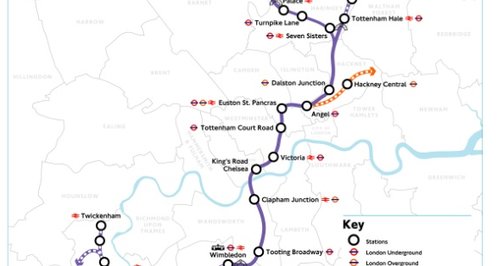On Air Now
Early Breakfast with Lindsey Russell 4am - 6:30am
28 October 2014, 11:38 | Updated: 28 October 2014, 11:49

The latest plans for the route of a second Crossrail project under London have been revealed by the Mayor's office.
The high capacity line would link south west and north east London and could stretch as far as Surrey and Hertfordshire.
In a keynote speech at the ‘City Age’ conference, the Mayor argued that even with the current Tube modernisation programme and the delivery of Crossrail 1, Crossrail 2 is needed to provide vital new capacity on the transport network to cope with London’s forecast population growth.
London's population's expected to reach 10 million by 2030 and 11.3m by 2050. By 2050 the demand for public transport will have increased by 60 per cent on the Underground and 80 per cent on the national rail network compared to current levels.
Bosses say the arrival of High Speed 2 in the early 2030s will result in particular pressure on the London Underground network, with potential for 30 minutes of queues at Euston to access the Victoria Line in the morning peak without Crossrail 2. Crossrail 2 is also designed to address rail capacity constraints in the south-west, as well as providing vital new connections across the capital to help to support economic growth, providing opportunities for thousands of new jobs and homes.
The Mayor said he was confident that, as with Crossrail 1, London could in the right circumstances contribute well over half the cost of Crossrail 2, reducing the demand on the UK taxpayer as a whole. He says if the pattern of Crossrail 1 were followed, more than 60% of the contracts would be with suppliers outside London, many of them small and medium-sized businesses.
The Mayor says Crossrail 2 is unique in its ability to relieve overcrowding on the Tube and national rail networks. It will slash journey times across London.
A journey from Kingston to Tottenham Court Road could be completed in just 29 minutes, 17 minutes faster than today. Those travelling between Dalston and Tottenham Court Road would have just an 8 minute journey, 19 minutes faster than today. Crossrail 2's benefits would also be felt far beyond the capital. Passengers on mainline trains travelling in to Waterloo from as far afield as Portsmouth, Southampton and Basingstoke would also benefit from the new rail line, which would relieve congestion at Waterloo by diverting suburban services into a new tunnel under London.
A consultation on the route showed strong support for the scheme with over 80 per cent expressing support. On the options consulted, most people support an extension from Alexandra Palace to New Southgate. There was also strong support for a station at Kings Road, Chelsea, as well as support for two potential station options in Hackney – Hackney Central and Dalston Junction.
Boris Johnson said: “Crossrail 2 is a vital project not just for the capital, but also for the regions from which people travel in to London on packed trains each day of the week.
"With London’s population soon to surpass its previous 1939 peak of 8.6m, and with more people travelling by Tube and rail than ever before, we need additional rail capacity to support future growth. For the capital to remain globally competitive there needs to be continued investment in our transport network and that’s why we have to get cracking on planning for Crossrail 2.
"It’s an essential infrastructure project that will deliver thousands of new homes and jobs, as well as helping to keep our great city moving.”
Michele Dix, TfL’s Managing Director for Planning, said: “The results of the second consultation held earlier this year showed widespread support for the new rail link. We need to continue to move forward with this scheme to identify funding options and safeguard the route, which will benefit London and beyond. Working collaboratively with Network Rail the next stage of work will look at the route and stations in more detail, engaging further with the local authorities, communities and other key stakeholders along the route.”
Network Rail’s strategy and planning director, Paul Harwood, said: “London’s railways are already the busiest and most congested in the country, with many main lines operating at, or close to, capacity. Working jointly with TfL we must press on with schemes such as Crossrail 2 so that public transport continues to support and drive economic growth in the capital and across the south east.”
The estimated project cost is around £20bn. Working jointly to TfL and DfT consultants PricewaterhouseCoopers (PwC) are undertaking a funding and finance feasibility study. PwC’s report examines a range of funding options, and will be published before the Autumn Statement. The Mayor and TfL believe the wider UK economic and transport benefits also support the case for a Government contribution to the cost.
The Department for Transport (DfT) will consult on proposed changes to the safeguarding, updating the previously safeguarded Chelsea – Hackney line, which dates back to 1991. The consultation will engage with the relevant local planning authorities and will also inform occupiers whose land and property is within 200 metres of land that may be needed in the future. Subject to the outcome of the consultation process, the Secretary of State will issue a Safeguarding Direction for Crossrail 2 in 2015.
Subject to this, the next steps for Crossrail 2 will be a consultation on a single preferred route option and station/worksite locations from September 2015. More detailed design will then be needed and an Application for Powers to build could take place in 2017 with the railway being operational by 2030.